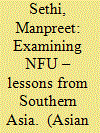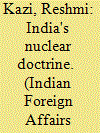|
|
|
Sort Order |
|
|
|
Items / Page
|
|
|
|
|
|
|
| Srl | Item |
| 1 |
ID:
187517


|
|
|
|
|
| Summary/Abstract |
The concept of NFU has been around for many decades, but only two of the nine nuclear armed nations have declared NFU doctrines. Both of these China and India, are in Southern Asia, a region that houses three geographically contiguous states with nuclear weapons. Pakistan, the third nuclear armed country in the region, rejects NFU. The paper examines the disparate positions of the three countries in order to find their motivations for and objections against NFU. By understanding their decisions to accept or reject NFU, one can test the strength of the arguments normally made in favour of first use. The paper showcases the utility of NFU as an effective credible strategy that achieves the objective of deterrence at least risk. Such a posture also demands less onerous arsenal requirements, liberates the decision maker from having to lay down redlines on use of nuclear weapons, and eases the ‘'lose or use’' dilemma of the adversary. Meanwhile, first nuclear use presents itself as not only a dangerous but also non-credible strategy, especially where the adversary has a secure second strike capability. Understanding the benefits of NFU and futility of first use can also help shape global acceptability of NFU as a step towards nuclear disarmament. Till such time as all stakeholders can be convinced of the desirability and feasibility of such a world, acceptance of NFU can be a safe way station.
|
|
|
|
|
|
|
|
|
|
|
|
|
|
|
|
| 2 |
ID:
132931


|
|
|
|
|
| Publication |
2014.
|
| Summary/Abstract |
The aim of India's nuclear deterrence capability has been to safeguard itself against blackmail and coercive diplomacy of adversaries. Its doctrinal principles of minimum nuclear deterrence and NFU are consistent with India's declaration of a modest nuclear weapons policy. The official announcements, in the aftermath of the May 1998 tests indicated that India has set out on a pragmatic course of action. Sixteen years after the tests, the Indian government's policies reflect this approach substantially.
|
|
|
|
|
|
|
|
|
|
|
|
|
|
|
|
| 3 |
ID:
187518


|
|
|
|
|
| Summary/Abstract |
No first use (NFU) of nuclear weapons is said to be an effective declaratory policy for advancing nuclear disarmament. In Japan, which suffered two atomic bombings, there are many voices that expect the US to declare the NFU, hoping to promote nuclear disarmament. In the meantime, Japan faces a tough security environment with North Korea's growing nuclear and missile capabilities and, above all, China's more assertive actions along with the expansion of both nuclear and conventional forces. The Japanese strategic community thinks that it is essential to maintain the credibility of the US extended deterrence and to further develop strike capabilities to counter China's medium-range strike capabilities in the region. In this context, there is a concern that a possible US declaration of NFU, while it may reduce the nuclear risk between the US and China, may signal to China that the US would allow China's assertive activities at the regional level. Measures must be taken to dispel concerns about such regional instability, and stakeholders should pursue stability at both strategic and regional levels so that declaratory policies such as NFU can effectively contribute to reducing nuclear threats and risks. To this end, it would be beneficial to discuss arms control and build confidence through a multi-layered strategic and arms control dialogues among primary players, namely one between the US and China, one among the US, Japan, and China, and another that add other regional players.
|
|
|
|
|
|
|
|
|
|
|
|
|
|
|
|
| 4 |
ID:
098976


|
|
|
| 5 |
ID:
127918


|
|
|
|
|
| Publication |
2013.
|
| Summary/Abstract |
At the time Cuban missile crisis in 1962, President Kennedy was presented with a set of alternative courses of action in response to the soviet deployment of nuclear tipped missiles in Cuba. These included undertaking military strikes on the missile bases in Cuba; invasion of the island; or a naval blockade of the country. The American President chose the last option because it was considered the least destabilising. The understanding of his security advisors was that any of the option employing US military force would quickly lead to Moscow retaliating by overrunning Berlin. The US would then have to get into a "general war" Which would, at some stage, require Washington to use nuclear weapons in a first strike, but also be prepared to suffer nuclear retaliation-an option that was described by president Kennedy to his Joint Chief of Staff as "a hell of an alternative".
|
|
|
|
|
|
|
|
|
|
|
|
|
|
|
|
|
|
|
|
|